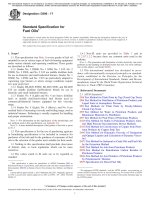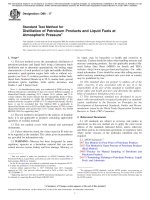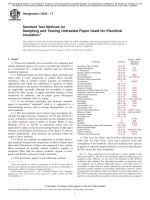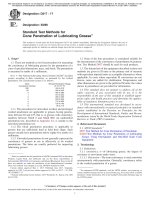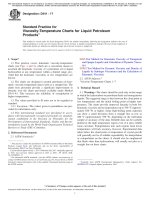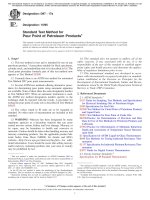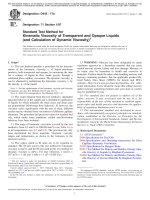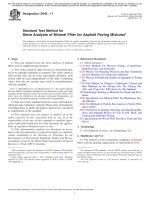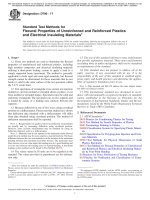Astm d 341 17
Bạn đang xem bản rút gọn của tài liệu. Xem và tải ngay bản đầy đủ của tài liệu tại đây (1.11 MB, 6 trang )
This international standard was developed in accordance with internationally recognized principles on standardization established in the Decision on Principles for the
Development of International Standards, Guides and Recommendations issued by the World Trade Organization Technical Barriers to Trade (TBT) Committee.
Designation: D341 − 17
Standard Practice for
Viscosity-Temperature Charts for Liquid Petroleum
Products1
This standard is issued under the fixed designation D341; the number immediately following the designation indicates the year of
original adoption or, in the case of revision, the year of last revision. A number in parentheses indicates the year of last reapproval. A
superscript epsilon (´) indicates an editorial change since the last revision or reapproval.
This standard has been approved for use by agencies of the U.S. Department of Defense.
1. Scope*
D445 Test Method for Kinematic Viscosity of Transparent
and Opaque Liquids (and Calculation of Dynamic Viscosity)
D7042 Test Method for Dynamic Viscosity and Density of
Liquids by Stabinger Viscometer (and the Calculation of
Kinematic Viscosity)
1.1 This practice covers kinematic viscosity-temperature
charts (see Figs. 1 and 2), which are a convenient means to
ascertain the kinematic viscosity of a petroleum oil or liquid
hydrocarbon at any temperature within a limited range, provided that the kinematic viscosities at two temperatures are
known.
2.2 ASTM Adjuncts:3
Viscosity-Temperature Charts 1–7
1.2 The charts are designed to permit petroleum oil kinematic viscosity-temperature data to plot as a straight line. The
charts here presented provide a significant improvement in
linearity over the charts previously available under Method
D341–43. This increases the reliability of extrapolation to
higher temperatures.
3. Technical Hazard
3.1 Warning—The charts should be used only in that range
in which the hydrocarbon or petroleum fluids are homogeneous
liquids. The suggested range is thus between the cloud point at
low temperatures and the initial boiling point at higher temperatures. The charts provide improved linearity in both low
kinematic viscosity and at temperatures up to 340 °C (approximately 650 °F) or higher. Some high-boiling point materials
can show a small deviation from a straight line as low as
280 °C (approximately 550 °F), depending on the individual
sample or accuracy of the data. Reliable data can be usefully
plotted in the high temperature region even if it does exhibit
some curvature. Extrapolations into such regions from lower
temperatures will lack accuracy, however. Experimental data
taken below the cloud point or temperature of crystal growth
will generally not be of reliable repeatability for interpolation
or extrapolation on the charts. It should also be emphasized
that fluids other than hydrocarbons will usually not plot as a
straight line on these charts.
1.3 The values provided in SI units are to be regarded as
standard.
1.3.1 Exception—The values given in parentheses are provided for information only.
1.4 This international standard was developed in accordance with internationally recognized principles on standardization established in the Decision on Principles for the
Development of International Standards, Guides and Recommendations issued by the World Trade Organization Technical
Barriers to Trade (TBT) Committee.
2. Referenced Documents
2.1 ASTM Standards:2
1
This practice is under the jurisdiction of ASTM Committee D02 on Petroleum
Products, Liquid Fuels, and Lubricants and are the direct responsibility of
Subcommittee D02.07 on Flow Properties.
Current edition approved July 1, 2017. Published July 2017. Originally approved
in 1932. Last previous edition approved in 2015 as D341 – 09 (2015). DOI:
10.1520/D0341-17.
2
For referenced ASTM standards, visit the ASTM website, www.astm.org, or
contact ASTM Customer Service at For Annual Book of ASTM
Standards volume information, refer to the standard’s Document Summary page on
the ASTM website.
3
Available from ASTM International Headquarters. Order Adjunct No.
ADJD0341CS. Original adjunct produced in 1965.
*A Summary of Changes section appears at the end of this standard
Copyright © ASTM International, 100 Barr Harbor Drive, PO Box C700, West Conshohocken, PA 19428-2959. United States
1
FIG. 1 Facsimile of Kinematic Viscosity-Temperature Chart I High Range (Temperature in degrees Celsius)
D341 − 17
2
FIG. 2 Facsimile of Kinematic Viscosity-Temperature Chart II Low Range (Temperature in degrees Celsius)
D341 − 17
3
D341 − 17
provided for convenience in connection with reports and data
evaluation. Charts III and IV are the same as Charts I and II and
are provided in greatly reduced scale for convenience in
connection with reports or quick evaluation of data. These
latter charts are not recommended for use where the most
accurate interpolations or extrapolations are desired.
4. Description
4.1 The charts are designed to permit kinematic viscositytemperature data for a petroleum oil or fraction, and hydrocarbons in general, to plot as a straight line over a wide range.
Seven charts are available as follows:3
Chart I—Kinematic Viscosity, High Range:
Kinematic Viscosity: 0.3 cSt to 20 000 000 cSt
Temperature: −70 °C to +370 °C
Size: 680 mm by 820 mm (26.75 in. by 32.25 in.)
Pad of 50
ADJD034101
Chart II—Kinematic Viscosity, Low Range:
Kinematic Viscosity: 0.18 cSt to 6.5 cSt
Temperature: −70 °C to +370 °C
Size: 520 mm by 820 mm (20.5 in. by 32.25 in.)
Pad of 50
ADJD034102
Chart III—Kinematic Viscosity, High Range:
Kinematic Viscosity: 0.3 cSt to 20 000 000 cSt
Temperature: −70 °C to +370 °C
Size: 217 mm by 280 mm (8.5 in. by 11.0 in.)
Pad of 50
ADJD034103
Chart IV—Kinematic Viscosity, Low Range:
Kinematic Viscosity: 0.18 cSt to 6.5 cSt
Temperature: −70 °C to +370 °C
Size: 217 mm by 280 mm (8.5 in. to 11.0 in.)
Pad of 50
ADJD034104
Chart V—Kinematic Viscosity, High Range:
Kinematic Viscosity: 0.3 cSt to 20 000 000 cSt
Temperature: −100 °F to +700 °F
Size: 680 mm by 820 mm (26.75 in. by 32.25 in.)
Pad of 50
ADJD034105
Chart VI—Kinematic Viscosity, Low Range:
Kinematic Viscosity: 0.18 cSt to 3.0 cSt
Temperature: −100 °F to +700 °F
Size: 520 mm by 820 mm (20.5 in. by 32.25 in.)
Pad of 50
ADJD034106
Chart VII—Kinematic Viscosity, Middle Range:
Kinematic Viscosity: 3 cSt to 200 000 cSt
Temperature: −40 °C to +150 °C
Size: 217 mm by 280 mm (8.5 in. by 11.0 in.)
Pad of 50
ADJD034107
5. Procedure
5.1 Plot two known kinematic viscosity-temperature points
on the chart. Draw a sharply defined straight line through them.
A point on this line, within the range defined in Section 3,
shows the kinematic viscosity at the corresponding desired
temperature and vice versa.
NOTE 1—If the kinematic viscosities are not known, they should be
determined in accordance with Test Method D445 or D7042. Test Method
D7042 results shall be bias-corrected by the application of the correction
described in Test Method D7042 for the specific sample type. In case of
dispute, Test Method D445 shall be the referee method.
5.2 Alternatively, the interpolated and extrapolated kinematic viscosities and temperatures may be calculated as
described in Annex A1, within the range identified for the
charts in Section 3.
6. Extrapolation
6.1 Kinematic viscosity-temperature points on the extrapolated portion of the line, but still within the range defined in
Section 3, are satisfactory provided the kinematic viscositytemperature line is located quite accurately. For purposes of
extrapolation, it is especially important that the two known
kinematic viscosity-temperature points be far apart. If these
two points are not sufficiently far apart, experimental errors in
the kinematic viscosity determinations and in drawing the line
may seriously affect the accuracy of extrapolated points,
particularly if the difference between an extrapolated temperature and the nearest temperature of determination is greater
than the difference between the two temperatures of determination. In extreme cases, an additional determination at a third
temperature is advisable.
7. Keywords
4.2 Charts I, II, V, and VI are preferred when convenience
and accuracy of plotting are desired. Chart VII is the middle
range section of Chart I at somewhat reduced scale. It is
7.1 charts; kinematic viscosity; MacCoull; viscosity;
viscosity-temperature charts
4
D341 − 17
ANNEX
(Mandatory Information)
A1. MATHEMATICAL EQUATIONS
A1.1 The complete design equation for the chart as given in
Appendix X1.1 is not useful for inter-calculations of kinematic
viscosity and temperature over the full chart kinematic viscosity range. More convenient equations4 that agree closely with
the chart scale are given below. These are necessary when
calculations involve kinematic viscosities smaller than
2.0 mm2/s (cSt).
log log Z = A 2 B logT
(A1.1)
Z 5 ν10.71exp~ 21.47 2 1.84ν 2 0.51ν 2 !
(A1.2)
where:
log
ν
T
A and B = constants.
A1.2 Inserting Eq A1.2 into Eq A1.1 will permit solving for
the constants A and B for a fluid in which some of the
experimental kinematic viscosity data fall below 2.0 mm2/s
(cSt). This form can also be used to calculate the temperature
associated with a desired kinematic viscosity.
ν 5 @ Z 2 0.7# 2 exp~ 2 0.7487 2 3.295 @ Z 2 0.7# 10.6119 @ Z
2 0.7# 2 2 0.3193 @ Z 2 0.7# 3 )
= logarithm to base 10,
= kinematic viscosity, mm2/s (or cSt),
= temperature, K (or t + 273.15, where t is °C), and
(A1.3)
A1.3 Conversely, the kinematic viscosity associated with a
stated temperature can be found from the equation determined
as in A1.2 by solving for Z in the substituted Eq A1.1, and then
subsequently deriving the kinematic viscosity from the value of
Z by the use of Eq A1.3.
4
Manning, R. E., “Computational Aids for Kinematic Viscosity Conversions
from 100 and 210°F to 40 and 100°C,” Journal of Testing and Evaluation, JTEVA,
Vol 2, No. 6, 1974, pp. 522–8.
APPENDIX
(Nonmandatory Information)
X1. HISTORY OF THE ASTM VISCOSITY-TEMPERATURE CHARTS
X1.4 The current charts were derived8 with computer assistance to provide linearity over a greater range on the basis of
the most reliable of modern data. The general relationship is:
X1.1 The forerunner of these charts was published by Neil
MacCoull.5 His continuation of the study of these charts
resulted in publication in 19276 of the chart based on
log log ~ c S t 1
0.7! 5 A 2 B log T
(X1.1)
log log Z 5 A 2 B log T
where:
Z
log
v
T
A and B
C
D
E
F
G
H
An ASTM committee undertook study of this chart at that
time, resulting in the first ASTM chart publication in 1932
using a constant of 0.8 in the equation. The constant was
allowed to vary in charts published after 1937.
X1.2 In 1928, Walther7 published the log-log Eq X1.1
without the constant, and in 1931, the log-log equation with a
constant of 0.8.
X1.3 The present MacCoull-Wright charts are based largely
on the work of MacCoull, Wright, and ASTM Subcommittee
D02.07.
=
=
=
=
=
=
=
=
=
=
=
(X1.2)
(v + 0.7 + C − D + E − F + G − H),
logarithm to base 10,
kinematic viscosity, mm2/s (or cSt),
temperature, K (or t + 273.15, where t is C),
constants,
exp (−1.14883 − 2.65868v),
exp (−0.0038138 − 12.5645v),
exp (5.46491 − 37.6289v),
exp (13.0458 − 74.6851v),
exp (37.4619 − 192.643v), and
exp (80.4945 − 400.468v).
X1.4.1 Terms C through H are exponentials on the natural
base e since this simplifies computer programming. Eq X1.1
uses logarithms to the base 10 for general convenience when
used in short form.
5
MacCoull, N., Lubrication, The Texas Company, New York, June 1921, p. 65.
6
1927 International Critical Tables, p. 147.
Walther, C., “ The Variation of Viscosity with Temperature–I, II, III,” Erdol und
Teer, Vol 5, 1928, p. 510, 526, 614.
7
8
Wright, W. A., “ An Improved Viscosity-Temperature Chart for Hydrocarbons,”
Journal of Materials, Vol 4, No. 1, 1969, pp. 19–27.
5
D341 − 17
given in Eq X1.2. The ASTM Slope was originally obtained by
physically measuring the slope of the kinematic viscositytemperature data plotted on the older charts given in Test
Method D341 – 43. The kinematic viscosity and temperature
scales were not made to the same ratios in Test Method
D341 – 43. The improved charts given here utilize even
different scale ratios for dimensional convenience and a different constant (0.7) from the older charts; consequently, the
original ASTM Slope is not numerically equivalent to B in Eq
X1.1 from any of the new charts, nor directly convertible from
Eq X1.1.
X1.4.2 The limits of applicability are listed below:
Z
Z
Z
Z
Z
Z
=
=
=
=
=
=
(v + 0.7)
(v + 0.7 + C)
(v + 0.7 + C − D)
(v + 0.7 + C − D + E)
(v + 0.7 + C − D + E − F + G)
(v + 0.7 + C − D + E − F + G − H)
2 × 10 7 to 2.00 cSt
2 × 10 7 to 1.65 cSt
2 × 10 7 to 0.90 cSt
2 × 10 7 to 0.30 cSt
2 × 10 7 to 0.24 cSt
2 × 10 7 to 0.21 cSt
X1.5 It is obvious that Eq X1.1 in the simplified form: log
log (v + 0.7) = A − B log T will permit kinematic viscosity
calculations for a given fluid in the majority of instances
required. The constants A and B can be evaluated for a fluid
from two data points. Kinematic viscosities or temperatures for
other points can then be readily calculated.
X1.6 Older literature refers to a value called the ASTM
Slope. It should be noted that this value is not the value of B
SUMMARY OF CHANGES
Subcommittee D02.07 has identified the location of selected changes to this standard since the last issue
(D341 – 09 (2015)) that may impact the use of this standard. (Approved July 1, 2017.)
(1) Revised Note 1 (formerly footnote 4) in subsection 5.1;
added Test Method D7042 to Referenced Documents.
ASTM International takes no position respecting the validity of any patent rights asserted in connection with any item mentioned
in this standard. Users of this standard are expressly advised that determination of the validity of any such patent rights, and the risk
of infringement of such rights, are entirely their own responsibility.
This standard is subject to revision at any time by the responsible technical committee and must be reviewed every five years and
if not revised, either reapproved or withdrawn. Your comments are invited either for revision of this standard or for additional standards
and should be addressed to ASTM International Headquarters. Your comments will receive careful consideration at a meeting of the
responsible technical committee, which you may attend. If you feel that your comments have not received a fair hearing you should
make your views known to the ASTM Committee on Standards, at the address shown below.
This standard is copyrighted by ASTM International, 100 Barr Harbor Drive, PO Box C700, West Conshohocken, PA 19428-2959,
United States. Individual reprints (single or multiple copies) of this standard may be obtained by contacting ASTM at the above
address or at 610-832-9585 (phone), 610-832-9555 (fax), or (e-mail); or through the ASTM website
(www.astm.org). Permission rights to photocopy the standard may also be secured from the Copyright Clearance Center, 222
Rosewood Drive, Danvers, MA 01923, Tel: (978) 646-2600; />
6
